集成学习实战之 -- RandomForest
一、引入
1.Linear model
∀ i ∈ { 1 , . . . , N } , y ^ i = ∑ j = 1 D w j X i j \forall_i\in{ \lbrace1,...,N\rbrace},\hat{y}_i=\sum^{D}_{j=1}w_jX_{ij} ∀i∈{1,...,N},y^i=j=1∑DwjXij
矩阵形式:
y
^
=
X
w
\boldsymbol{\hat{y}=Xw}
y^=Xw
a.用线性模型拟合非线性数据:
1)拟合较平滑的曲线
FIGSIZE = (15,8)
def ground_truth(x):
'''function to approximate'''
return x + 2 * np.sin(0.1*x) + np.sin(0.6*x)
def gen_data(n_samples=200):
'''产生训练和测试数据'''
np.random.seed(42)
X = np.random.uniform(0,10,size=n_samples)[:, np.newaxis]
y = ground_truth(X.ravel()) + np.random.normal(scale=2,size=n_samples)
X_train, X_test, y_train, y_test = train_test_split(X, y, test_size=0.2, random_state = 3)
return X_train, X_test, y_train, y_test
def plot_data(alpha=0.7, s=20):
fig = plt.figure(figsize=FIGSIZE)
gt = plt.plot(x_plot, ground_truth(x_plot), alpha=alpha, label='ground truth')
plt.scatter(X_train, y_train, s=s, alpha=alpha)
plt.scatter(X_test, y_test, s=s, alpha=alpha, c='r')
plt.xlim((0,10))
plt.ylabel('y')
plt.xlabel('x')
X_train, X_test, y_train, y_test = gen_data(100)
x_plot = np.linspace(0, 10, 500)
plot_data()
# 导入线性模型
est = LinearRegression().fit(X_train, y_train)
x_pred_1 = est.predict(x_plot[:,np.newaxis])
plt.plot(x_plot, x_pred_1, label='Linear Regression', c='g', alpha=0.4, linewidth=3)
plt.legend(loc='upper left')
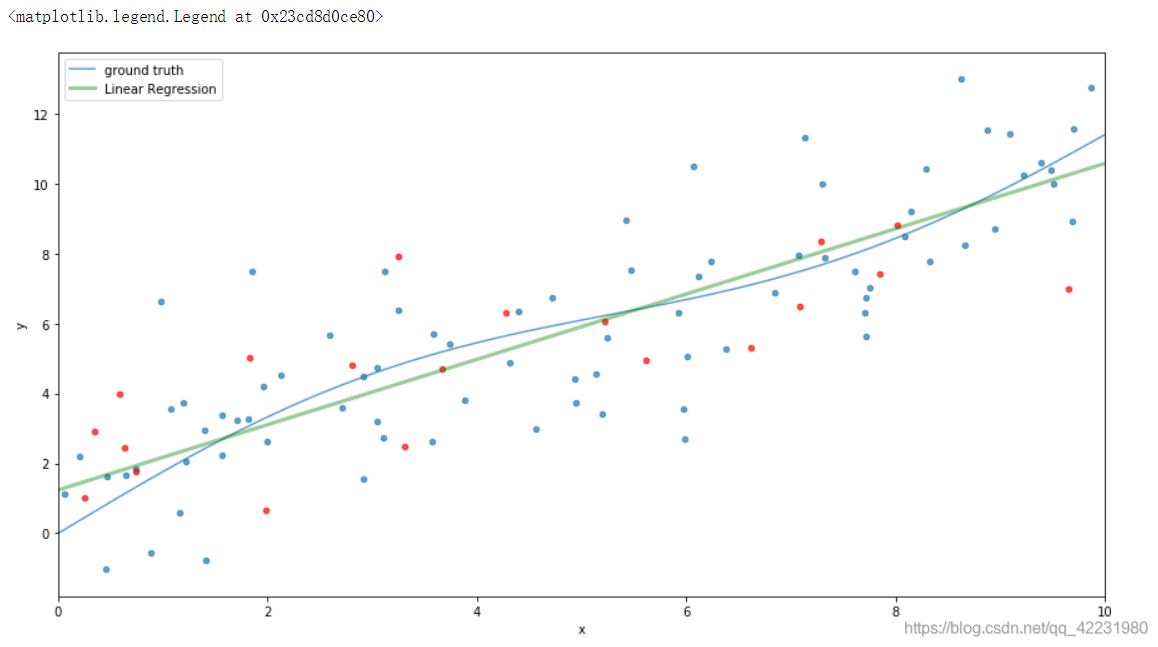
2)拟合不规则曲线
FIGSIZE = (15,8)
def ground_truth(x):
'''function to approximate'''
return x * np.cos(x) + 2 * np.sin(2*x) + np.sin(3*x)
def gen_data(n_samples=200):
'''产生训练和测试数据'''
np.random.seed(42)
X = np.random.uniform(0,10,size=n_samples)[:, np.newaxis]
y = ground_truth(X.ravel()) + np.random.normal(scale=2,size=n_samples)
X_train, X_test, y_train, y_test = train_test_split(X, y, test_size=0.2, random_state = 3)
return X_train, X_test, y_train, y_test
def plot_data(alpha=0.7, s=20):
fig = plt.figure(figsize=FIGSIZE)
gt = plt.plot(x_plot, ground_truth(x_plot), alpha=alpha, label='ground truth')
plt.scatter(X_train, y_train, s=s, alpha=alpha)
plt.scatter(X_test, y_test, s=s, alpha=alpha, c='r')
plt.xlim((0,10))
plt.ylabel('y')
plt.xlabel('x')
X_train, X_test, y_train, y_test = gen_data(100)
x_plot = np.linspace(0, 10, 500)
plot_data()
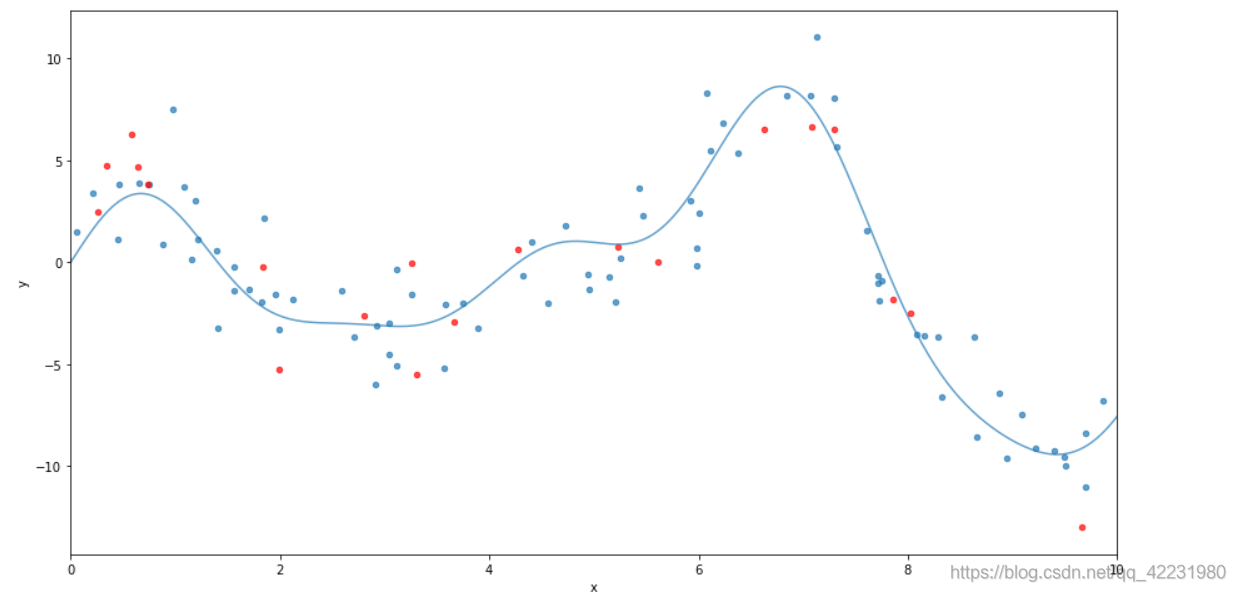
plot_data()
est = LinearRegression().fit(X_train, y_train)
x_pred_1 = est.predict(x_plot[:,np.newaxis])
plt.plot(x_plot, x_pred_1, label='Linear Regression', c='r', alpha=0.4, linewidth=3)
plt.legend(loc='upper left')
此时再用线性拟合,效果非常的不好:
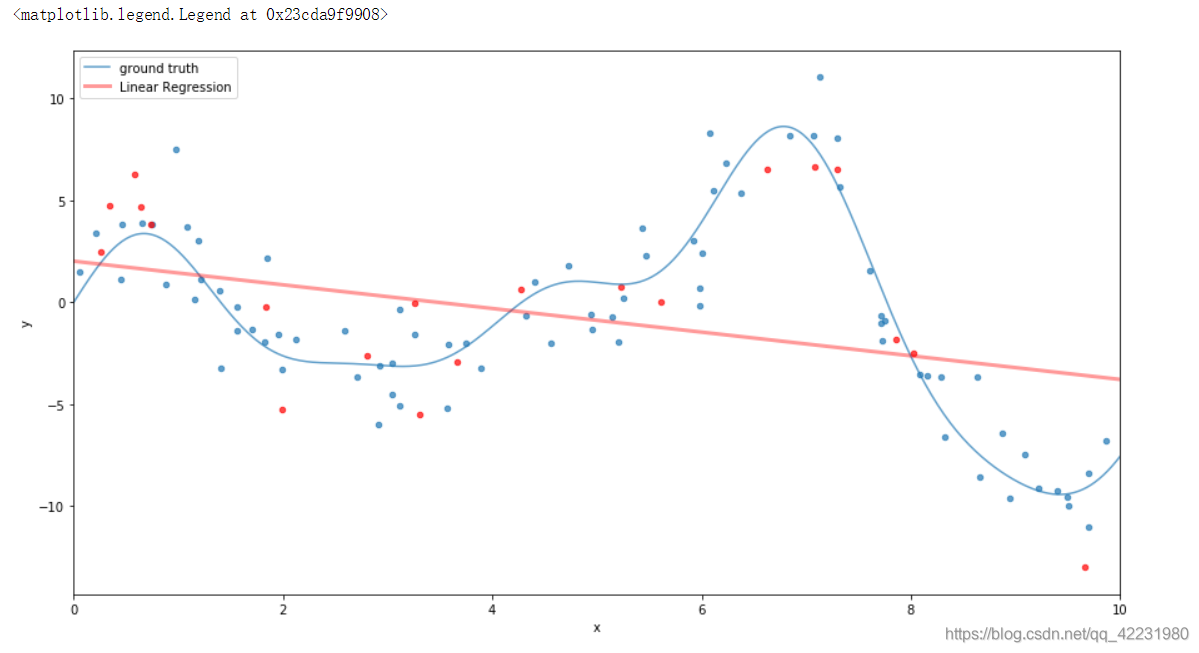
从图中可以看出,线性模型非常努力去贴合,但线性模型容量有限,不能拟合非线性的数据。
2.引入决策树
a.两个问题
1)决策树是线性模型吗?
- 一般都是非线性模型。
2)决策树能解决上面的问题吗?
后面给出答案。
b.决策树的特点
优点:
- 易解释(用了哪些特征去分离数据,阈值是多少,甚至可以手动写出一套规则)
- 原生支持特征选择
- 无需归一化
- 训练快
缺点:
- low bias, high variance
- 不稳定,error propagation(每一次决策依赖上一次)
可以参考:决策树实战
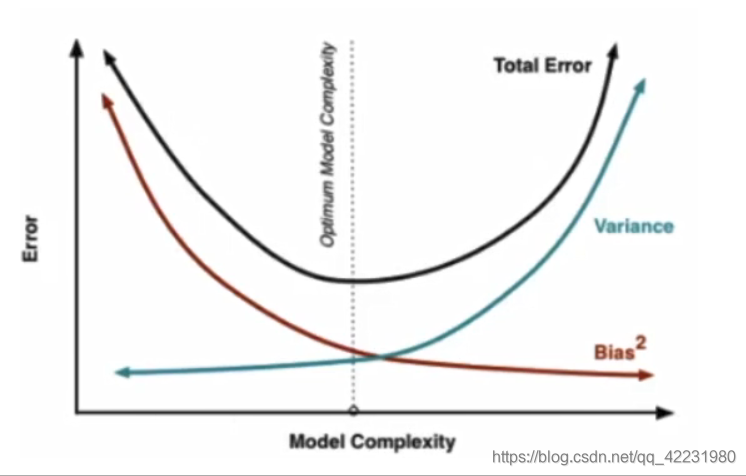
c.拟合数据
plot_data()
# 设置最大深度,分类一次
est = DecisionTreeRegressor(max_depth=1).fit(X_train, y_train)
x_pred_1 = est.predict(x_plot[:, np.newaxis])
plt.plot(x_plot, x_pred_1, label='DecisionTree max_depth=1',c='m', alpha=0.6, lw=1)
#随着深度的增加,单颗决策树在训练集上的准确率增加
est = DecisionTreeRegressor(max_depth=2).fit(X_train, y_train)
plt.plot(x_plot, est.predict(x_plot[:, np.newaxis]),
label='RT max_depth=2', alpha=0.6, c='r', lw=2)
# 但深度一直增加会让训练集完全拟合,出现过拟合,使泛化能力变差
est = DecisionTreeRegressor(max_depth=20).fit(X_train, y_train)
plt.plot(x_plot, est.predict(x_plot[:, np.newaxis]),
label='RT max_depth=10', alpha=0.6, c='g', lw=2)
plt.legend(loc='upper left')
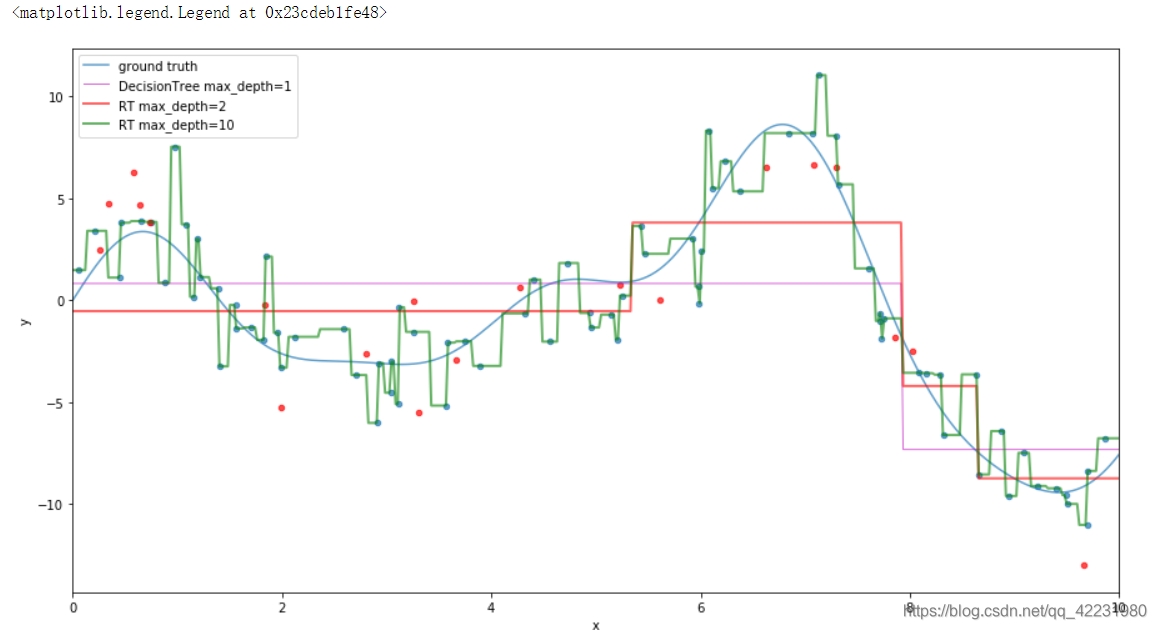
二、模型融合
1.Bagging
现在可以回答“决策树能解决上面的问题吗?”,不完全能,因为决策树的缺点:依赖于上一次的决策,方差大容易过拟合。
减少方差的办法:Bagging,在训练集不同的随机抽取,构成
M
M
M个子训练集,每个训练集分别训练一棵树
f
m
(
x
)
f_m{(x)}
fm(x)
然后构成一个集成模型:
f
(
x
)
=
∑
m
=
1
M
1
M
f
m
(
x
)
f(x)=\sum^{M}_{m=1}\frac{1}{M}f_m{(x)}
f(x)=m=1∑MM1fm(x)
2.Random Forest
简单的Bagging导致训练出来的子模型高度相关,甚至是一样的模型,导致集成后的模型方差仍然很大。
解决:除了训练集随机构造,feature也随机选择一部分训练,这就是Random forest。
a.手动构建
plot_data()
col_sample = 0.6
seed_1 = np.random.RandomState(4)
# 随机采样80%
idx_1 = seed_1.randint(X_train.shape[0], size=int(col_sample*X_train.shape[0]))
# 当树的深度为20时,与上面对比,因为抽样80%所以并未完全拟合(蓝色的点)。
est = DecisionTreeRegressor(max_depth=20).fit(X_train[idx_1], y_train[idx_1])
x_pred_1 = est.predict(x_plot[:, np.newaxis])
# plt.plot(x_plot, x_pred_1, label='DecisionTree max_depth=1', c='g', alpha=0.5, lw=1)
# 对比:随机采样所以拟合的点不一样
idx_2 = seed_1.randint(X_train.shape[0], size=int(col_sample*X_train.shape[0]))
est = DecisionTreeRegressor(max_depth=20).fit(X_train[idx_2], y_train[idx_2])
x_pred_2 = est.predict(x_plot[:, np.newaxis])
# plt.plot(x_plot, x_pred_2, label='DecisionTree max_depth=2', c='r', alpha=0.5, lw=1)
#
idx_3 = seed_1.randint(X_train.shape[0], size=int(col_sample*X_train.shape[0]))
est = DecisionTreeRegressor(max_depth=20).fit(X_train[idx_3], y_train[idx_3])
x_pred_3 = est.predict(x_plot[:, np.newaxis])
# plt.plot(x_plot, x_pred_3, label='DecisionTree max_depth=3', c='m', alpha=0.4, lw=1)
# 求均值,减缓过拟合(Bagging的思想)
x_pred_mean = np.mean([x_pred_1, x_pred_2, x_pred_3], axis=0)
plt.plot(x_plot, x_pred_mean, label='DecisionTree mean', c='b', alpha=0.3, lw=2)
plt.legend(loc='upper left')
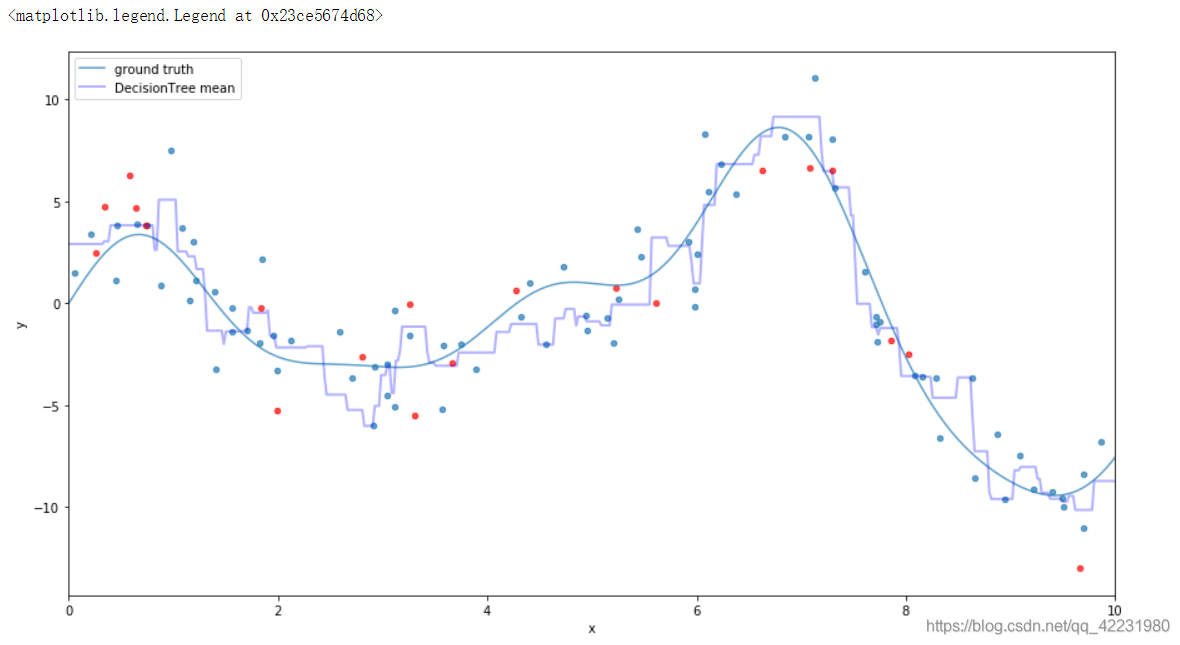
a.用sklearn中的模型构建
plot_data()
# est = RandomForestRegressor(n_estimators=10, max_depth=3).fit(X_train, y_train)
# plt.plot(x_plot, est.predict(x_plot[:, newaxis]),
# label='RF n_estimator=10, max_depth=3', c='g',alpha=0.9,lw=2)
# est = RandomForestRegressor(n_estimators=100, max_depth=5).fit(X_train, y_train)
# plt.plot(x_plot, est.predict(x_plot[:, newaxis]),
# label='RF n_estimator=100, max_depth=5', c='g',alpha=0.7,lw=2)
#
est = RandomForestRegressor(n_estimators=100, max_depth=5).fit(X_train, y_train)
plt.plot(x_plot, est.predict(x_plot[:, newaxis]),
label='RF n_estimator=5, max_depth=5', c='g',alpha=0.5,lw=2)
plt.legend(loc='upper left')
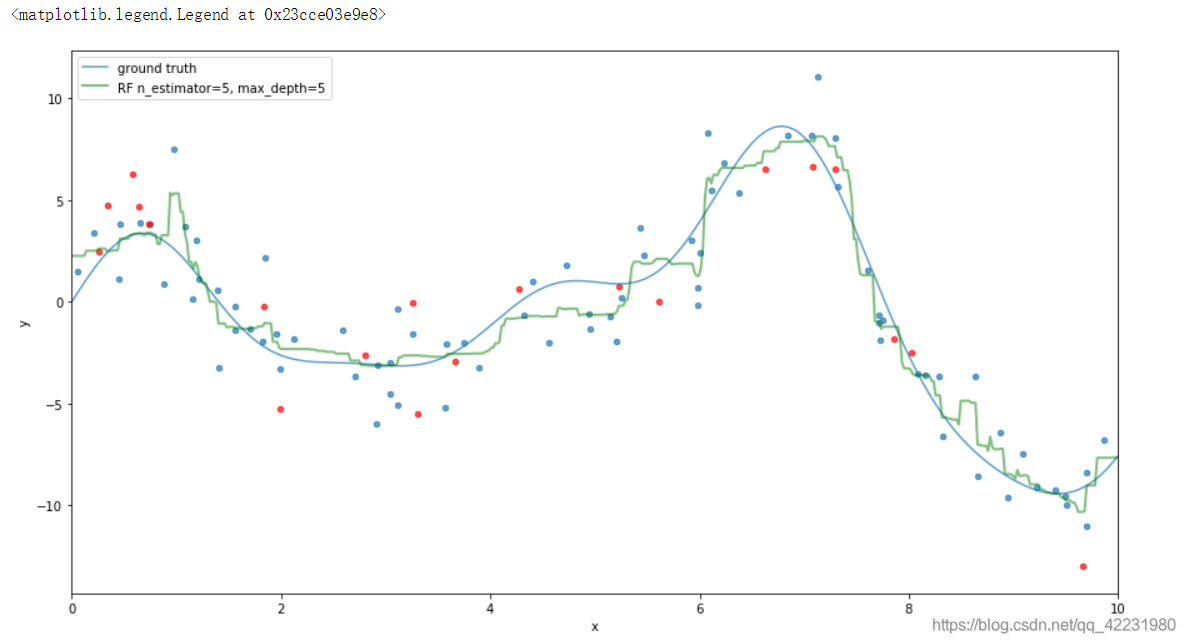










 本文介绍了集成学习中的Random Forest模型,从线性模型无法有效拟合非线性数据开始,引出决策树及其特点。接着探讨了Bagging方法以解决决策树的方差问题,最后详细阐述了Random Forest如何通过随机选取特征降低模型相关性,提高预测性能。
本文介绍了集成学习中的Random Forest模型,从线性模型无法有效拟合非线性数据开始,引出决策树及其特点。接着探讨了Bagging方法以解决决策树的方差问题,最后详细阐述了Random Forest如何通过随机选取特征降低模型相关性,提高预测性能。
















 2121
2121

 被折叠的 条评论
为什么被折叠?
被折叠的 条评论
为什么被折叠?








